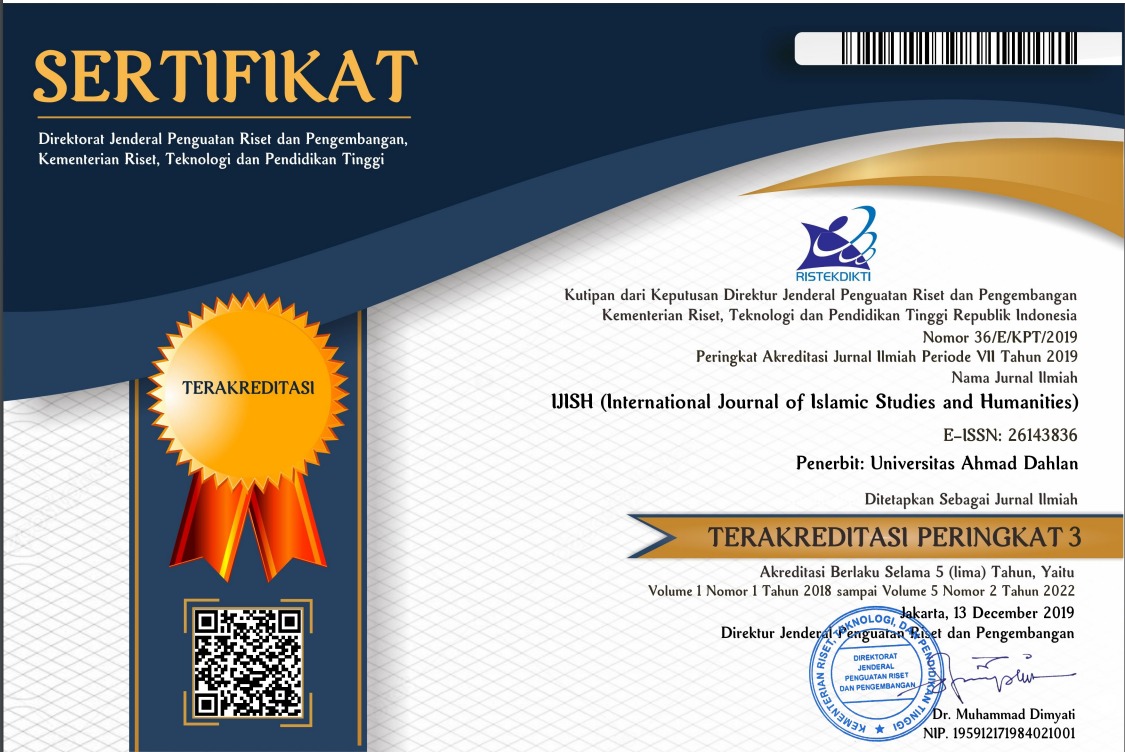Fashions in Prayer Exhibit the Mysterious Love of Prophet Muhammad (SAW) to Allah (SWT)
DOI:
https://doi.org/10.26555/ijish.v3i1.1196Keywords:
Human statue, Structure of Human skeleton, Structure of Arabic words Muhammad (PBUH) and Allah (SWT), Love of Allah to Muhammad (SAW).Abstract
This study presents a structural view of the mysterious love of Prophet Muhammad (Sallallahu Alaihe Wasallam: SAW) to Allah (Subhanahu-Wa-Ta’ala: SWT) through the body fashions in prayer (Salah). The fashions in the unit of prayer (one Rak’ah Salah) are the sequence of (1) stand upright facing the direction of Al-Ka'bah, (2) bow down (Ruku), (3) stand up and (4) prostration (Sujood). In this study, the fashions in prayer were analyzed from the structural view point of human body. These observations have shown that the four fashions of body in a one unit (rak’ah) prayer represent the structure of four Arabic letters: (1) Alif ( ), (2) Lam (  ), (3) Lam (  ) and (4) Ha (  ). Consequent arrangement of these four letters leading the structure of Arabic word Allah (       ) which means the performing of one rak’ah salah, providing the internal written of the name of Allah (      ). Thus the Muslims become close to Allah (SWT) by performing prayer. Again, the recent development in medical science has shown that the skeleton structure of human body represents the structure of the Arabic word Muhammad       (            ) (SAW) (American Journal of Medical Science and Medicine, Vol. 6, No. 1, page 1-4, January 2018). Therefore, as a whole, the fashions in prayer represent the internal written of the name of Allah       (     ) (SWT) through the name of prophet Muhammad (SAW) as the structure of human body. These body fashions in prayer, practiced by Prophet Muhammad (SAW), exhibited the greatest love of Prophet Muhammad (SAW) to Allah (SWT).
References
Al-Khattab, Nasiruddin, Sahih Muslim, 1629 and Salat 21518, English Translation, Edited by Huda Khattab, King Fahd National Library Catalog-in-Publication Data, Maktaba Dar-us-Salam. 2007.
Farid-ul-Haque, Shah, The Holy Qur’an: English Translation, Published by Kanz-ul-Eeman, Noore Madinah Network, 1997, 50:39-40. (Sura: Qaf, Ayat 39-40), 2:125 (Sura: Al-Baqarah, Ayat 125), 29:45 (Sura: An-Ankabut, Ayat 45), 96: 19 (Sura: Al-Baqarah, Ayat 19).
Hossain, Mohammad Abul, Significance of the structure of human skeleton, American Journal of Medical Science and Medicine, Vol. 6, no. 1, 2018, pp. 1-4.
Hossain, Mohammad Abul16, Structure of Human Skeleton Exhibits the Mysterious Love of Allah (SWT) to Prophet Muhammad (SAW), International Journal of Islamic Studies, Vol. 5, No. 1, 2018, pp. 13-39.
Kathir, Ismail Ibn, Tafseer Ibne Kaseer/Kathir, English Translation, 2009, vol. 1–10 (7/164).
Khan, M. Muhsin, Saheeh Al-Bukhari, 3498 and 41619, English Translation, Published by King Fahd National Library Catalog-in-Publication Data, Maktaba Dar-us-Salam, Saudi Arabia, 2009.
Mafatih al-jinan, iv, 688.
Muhammad Taqi-ud-Din Al- Hilali and Muhammad Muhsin Khan, The Holy Qur’an: English Translated, Published by King Fahd Complex for the printing of Holy Quran, Madinah Al-Munawarah, Saudi Arabia, 1997, 20:14 (Sura: Taha, Ayat 14), 22:77 (Sura: Al-Haj, Ayat 77), 30:17-18 (Sura: Ar-Rum, Ayat 17-18).
Sunan Ibn Majah 4169.
Usul al-Kafi, II, Kitab al-Iman wa al-kufr†bab man adha al-muslimin†Hadith No. 08.
Downloads
Published
How to Cite
Issue
Section
License
Authors who publish with IJISH (International Journal of Islamic Studies and Humanities) agree to the following terms:
- Authors retain copyright and grant the journal right of first publication with the work simultaneously licensed under a Creative Commons Attribution License (CC BY-SA 4.0) that allows others to share the work with an acknowledgment of the work's authorship and initial publication in this journal.Â
- Authors are able to enter into separate, additional contractual arrangements for the non-exclusive distribution of the journal's published version of the work (e.g., post it to an institutional repository or publish it in a book), with an acknowledgment of its initial publication in this journal.
- Authors are permitted and encouraged to post their work online (e.g., in institutional repositories or on their website) prior to and during the submission process, as it can lead to productive exchanges, as well as earlier and greater citation of published work.

This work is licensed under a Creative Commons Attribution-ShareAlike 4.0 International License.






